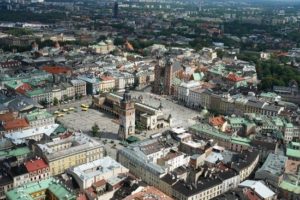 While in Krakow I read George Weigel’s book on the city entitled City of Saints: A Pilgrimage to John Paul II’s Krakow. I cannot think of a more fitting title about a city that has the ethos of sanctity emanating from its streets. Like a fountain, waters of sanctity and history flow from Wawel Hill meandering into the Main Square, thereby soaking into the lives of its people. I hope I do not sound like Krakow is the New Jerusalem; it is a city of sinners and saints. However, from what I witnessed it seems to me that a city can do an awful lot in shaping a man in either direction. Krakow concretely orders man to his destiny of communion with God in Christ. That is partially why no atheistic regime that denied such a destiny could triumph there. Sanctity haunts Krakow.
While in Krakow I read George Weigel’s book on the city entitled City of Saints: A Pilgrimage to John Paul II’s Krakow. I cannot think of a more fitting title about a city that has the ethos of sanctity emanating from its streets. Like a fountain, waters of sanctity and history flow from Wawel Hill meandering into the Main Square, thereby soaking into the lives of its people. I hope I do not sound like Krakow is the New Jerusalem; it is a city of sinners and saints. However, from what I witnessed it seems to me that a city can do an awful lot in shaping a man in either direction. Krakow concretely orders man to his destiny of communion with God in Christ. That is partially why no atheistic regime that denied such a destiny could triumph there. Sanctity haunts Krakow.
Many saints lived and died in Krakow. Their monuments are all over the city. Little shrines surprisingly pop up everywhere, even next to a McDonalds by the city’s main gate. A huge crucifixion scene dominates a street that is also littered with clubs and bistros. Nowhere else besides Rome have I seen so many religious. Christ shines everywhere.
Instead of secular skyscrapers, Churches dominate the city’s skyline. Streets from the main square, with names of saints, apostles and evangelists, lead to the façade of Churches and other institutions of importance. An enormous shopping mall fittingly sits on the outskirts of the city, allowing the city’s hierarchy of importance, derived from a Christian vision of things, to be unambiguously expressed. This was revelatory to me. I grew up in a centerless suburb, dominated by a lifeless shopping mall, an inversion of the order expressed in Krakow.
My wife and I met a close friend of John Paul II, the poet/philosopher Stanislaw Grygiel, in the Main Square. Commenting on the different ethos we noticed between Warsaw and Krakow, Grygiel said, “People in Warsaw talk politics. The people of Krakow talk about the Bishop’s homily.” The city had a long history of being Poland’s political center, but it no longer has that role; perhaps, for the better. Yet even when it did have that role, a different vision shaped politics than the one we have today. For the past century, politics has been dominated by a liberal secularism, anything outside its framework seen as an obstruction of justice. Krakow was the center when a noble culture was present that could state in the Preamble to the Act of Horodlo (1413): ‘Whoever is unsupported by the mystery of Love…shall not achieve the Grace of salvation…For by Love, laws are made, kingdoms governed, cities ordered, and the state of the commonweal is brought to its proper goal. Whoever shall cast Love aside, shall lose everything.’ You can see this ordering principle governing the streets of Krakow and the lives of its inhabitants. I only notionally understood ta city was so essential to the shaping its citizens, but now, after walking the streets of Krakow and meeting many Krakowians, I really understand why a city is a major factor in sanctity. Weigel remarks that you cannot fully understand John Paul II without Krakow. He is right. The love that orders the streets of Krakow is the same love that ordered the life of St. John Paul II. We all have much to learn from cities like Krakow, and I do not think it is nostalgic to think that such an order can reestablish cities and the lives of people longing to live the holiness of God. Perhaps, urban planners, politicians, and religious should get together to lay the foundation for cities open to God. This may be one of the reasons why Krakow historically was the home of many vocations.
For more on the urban planning of Krakow, watch Dr. Denis McNamara’s video on the city.
//www.youtube.com/watch?v=YchwHjON3co&t=15s